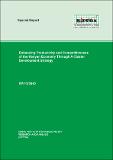| dc.date.accessioned | 2021-07-29T09:20:16Z | |
| dc.date.available | 2021-07-29T09:20:16Z | |
| dc.date.issued | 2012 | |
| dc.identifier.uri | http://repository.kippra.or.ke/handle/123456789/3066 | |
| dc.description.abstract | The world economy is undergoing rapid change
associated with globalization and liberalization,
which has increased the need for industrial
competitiveness. Kenya ranks low in global
competitiveness and compares unfavourably with
the East Asian economies that Kenya aspires to
catch up with. During the past four decades, the government
has implemented various policy tools to
enhance competitiveness and transformation
of the economy, but the level of success has
been low. Conscious of the challenges facing the Kenyan
economy, the National Economic and Social
Council (NESC) recommended the adoption
of a cluster development strategy. Cluster
development strategies and the new structural
economics represent an emerging middle ground
in development thinking between heavy state
interventions and unbridled free markets. Clusterbased
development strategies recognize the
fundamental role of the invisible hand of the market
and the strategic role of the state in facilitation
and coordination of development efforts towards
economic transformation. | en |
| dc.language.iso | en | en |
| dc.publisher | The Kenya Institute for Public Policy Research and Analysis (KIPPRA) | en |
| dc.relation.ispartofseries | SP/13/2012; | |
| dc.subject | Clustered development | en |
| dc.subject | Sectoral performance | en |
| dc.subject | Global competitiveness | en |
| dc.subject | Economic productivity | en |
| dc.title | Special Paper No. 13 of 2012 on Enhancing Productivity and Competitiveness of the Kenyan Economy Through a Cluster Development Strategy | en |
| dc.type | KIPPRA Publications | en |
| ppr.contributor.author | The Kenya Institute for Public Policy Research and Analysis (KIPPRA) | en |

